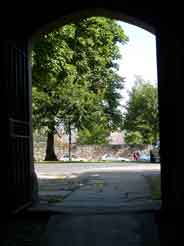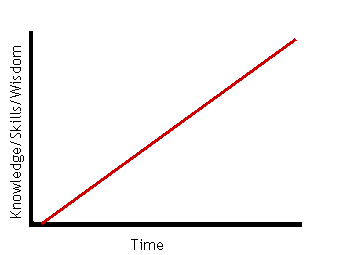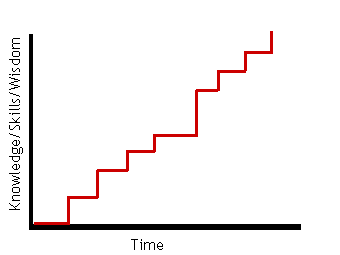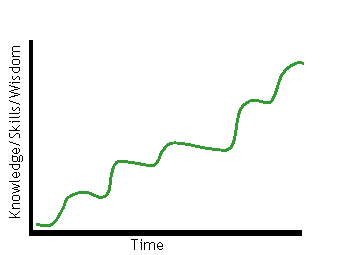Threshold concepts—another angle
Most of our planning for teaching is pretty crude. It's worse than that, it's hopeless. We-and particularly our managers-like to pretend that it isn't. We (they) devise fancy forms for "Schemes of Work" and "Lesson Plans" full of "SMART" objectives and incomprehensible coded cross-references to the syllabus. But we know that however carefully we have "planned", by the third week there is only the most tenuous connection between the reality of student learning and the fantasy of our teaching plan. What happened?
First, we got arrogant. Under pressure from management regimes in education which are desperately trying to catch up to systems of organisation which clued-up business abandoned in the late 'sixties, teachers have had to specify in ever greater detail what will be "achieved" in every session. It is, of course, nonsense. There is no way in which we can specify what any individual student will learn within a given hour of teaching (and pandering to their so-called "learning styles" will not make it happen, either). But we have been conditioned to believe that we can create a sausage machine of such efficiency.
Second, in our obsession with "delivering" teaching, we forgot about how students acquire learning. We even have courses on "delivering learning"! No! I can deliver food. You have to eat it. Unless you eat it, it makes no difference to you (for better or for worse, given the current concerns about obesity, but we won't go there). Teaching is cooking. Learning is eating. ...
Underpinning both misconceptions (alongside all the stuff from on high) is a simplistic view of learning. It's wrong, but the more we explore how and why it is wrong, the more interesting-and useful-the story gets.
At the heart of that view is a model of learning which can be represented thus;
It assumes a steady and inexorable incremental progression. Indeed, in some limited cases it does apply; it broadly works in the acquisition of precise but limited manual skills, such as gutting fish, where experienced practitioners just get better and faster—within very clear limits. It broadly works, too, for memorisation; but even here there are features such as cueing (where one item brings to mind a series of others) which introduce "lumpiness" into that pristine line.
But most skills and knowledge are acquired in a more complex context than fish-gutting. (And once the really tricky problem has been solved, of how to grab and align a slippery slithery silvery creature, fish-gutting may be a job for robots. Indeed, the straightness of the red learning "curve" may be an indication of the suitability of the task for computerised mechanisation.)
Most real-world learning though, examined up close, follows a "stepped" pattern or a "stick and slip" process.
The steps are not uniform, and not everyone's steps are the same. The risers (vertical bits), when learning suddenly accelerates, are those points at which the "penny drops", or you "get it" or "get the knack", and they are not entirely predictable. And because they are not predictable, they can play havoc with our planning. Usually they are followed by a period of consolidation before the next breakthrough, but organised systems of "education" tend to press on remorselessly with teaching the syllabus, regardless of whether all the learners have successfully negotiated their steps. So some learners may, for example, have memorised (or as one writer put it, "mimicked") some material without ever fully understanding its significance; they will pass our assessments but what they have "learned" remains largely a mystery to them.
As one of my students, an engineer, commented of one of his students; "he'll pass all the assessments, but he'll never think like an engineer". Getting a students to "think like" an engineer, a nurse, an economist—even, heaven help us, a lawyer—may be our ultimate goal. It is the acquisition of what Entwisle (2004) calls a "way of thinking and practising" or WTP, if you like jargon to impress with.
So far we have treated the steps as rather mysterious and arbitrary features of a learning career (or "journey", in the new cliché). Examine them more closely, however, and they prove not only to be rather more complicated than simple steps, but also much more revealing and interesting, with direct implications for practice. This examination has been started by Meyer and Land, and is rapidly growing into a very substantial area of research; what follows is an attempt to introduce it as simply as possible, albeit slightly indirectly; as Einstein reputedly said, "Make everything as simple as possible, but not simpler".
Einstein developed the theory of relativity from a thought-experiment, imagining what it would be like to ride on a beam of light. Try a similar thought-experiment, and put yourself in the position of a learner climbing the learning curve we have looked at. The first thing to strike you is that the uniform, steady slope is very boring; and indeed that is the experience of many of our students whose experience of a subject is squeezed into the limitations of the syllabus and a pre-determined teaching schedule and assessment regime.
But at least the slope is fairly manageable, if it has been constructed well, with some consideration of the abilities of the learners/climbers. Climbing the steps can be much harder, and sometimes they seem so big that you may be daunted by the prospect of ever getting up them; the knowledge they embody may in that sense (and some other senses, as we shall see) be "troublesome" (Perkins, 1999).
However, neither model, whether slope or steps, is anywhere near rich enough to describe what the climb is like. It would be more realistic to depict it as a hill-walk. It has elements of slope and step, but also it has a series of summits; one of the most frustrating but also rewarding aspects of a fell-walk is to breast a summit which you thought was the top of a hill, but which really just concealed another behind it. It was nonetheless an intermediate peak, and from it you can see both ahead and behind in a new way. It has revealed a cwm ahead which gives you a clearer idea of where you have to go, and you can now look back at where you have come from and see how the path led here.
In learning terms, that summit you have just breasted is a "threshold concept".
(There are several respects in which this analogy breaks down, but one of the more important ones is that the theory also suggests that—in learning terms—once you have moved on beyond that peak, you can't go back that way.)
What kind of learning is a threshold concept?
It is specific to a particular discipline or subject. There are no generic threshold concepts; as some investigators have pointed out, what counts as a threshold concept in one branch of engineering may not count as such in the branch next door.
It is not necessarily a great truth, except in the sense that it will transform how you see an aspect of your discipline. (Just to confuse you, it may not even be true.)
It is not just a core concept, in the sense simply of an important item on the syllabus which you really have to learn, although it may well be that. So far, an important component of the research is the task of working with subject experts in particular disciplines to identify their threshold concepts;
- Clouder (2005) argues that "caring", with all its emotional baggage, is a threshold concept for health-care professionals. Until students grasp what is involved in participating in a professional caring relationship, they have nothing on which to hang the rest of their learning, but engaging in that relationship can be (indeed perhaps it needs to be) deeply unsettling.
- That may be "obvious". Less obvious, perhaps, is the notion of "opportunity cost" in economics, or even (at a lower level) "price" as a product of the interaction of supply and demand rather than an inherent quality of a commodity (Entwistle, 2003). But you can see how critical it is; if you misunderstand "price" nothing else makes sense. Grasp it, and other things fall into place.
- Sometimes the concept is "simply" a matter of clarifying definitions. In electrical engineering, Carstensen and Bernhard (2007) note that students tend to confuse concepts such as voltage, current, power and energy. Clearing up that confusion also clears the way for future learning; any residual misunderstanding can really foul up the next steps, soaking up effort which could be going into new learning.
Why "threshold"?
 The term, "threshold" also suggests another metaphor, of a doorway giving onto and revealing a room ahead. The "logo" Ray Land uses in his presentations is of a portal opening onto light. And what it is giving onto is a new way of thinking and practising. We are not speaking of a once-and-for-all revelation or conversion
experience;
it is simply one more step along the way to understanding a subject and acquiring a professional identity. I mention both "understanding"
and "acquiring an identity" because Land and Meyer have identified that the transformation brought about by grasping a threshold concept changes not only your understanding of your subject, but also in some measure your understanding of yourself. (In the philosophical jargon you will find when you start reading the "proper" papers, the change is not only epistemological, but also ontological; but beware—this is hard-core jargon and it can become addictive!)
The term, "threshold" also suggests another metaphor, of a doorway giving onto and revealing a room ahead. The "logo" Ray Land uses in his presentations is of a portal opening onto light. And what it is giving onto is a new way of thinking and practising. We are not speaking of a once-and-for-all revelation or conversion
experience;
it is simply one more step along the way to understanding a subject and acquiring a professional identity. I mention both "understanding"
and "acquiring an identity" because Land and Meyer have identified that the transformation brought about by grasping a threshold concept changes not only your understanding of your subject, but also in some measure your understanding of yourself. (In the philosophical jargon you will find when you start reading the "proper" papers, the change is not only epistemological, but also ontological; but beware—this is hard-core jargon and it can become addictive!)
The change which occurs when "the penny drops", when a threshold concept is grasped, is believed to be irreversible under normal circumstances. Once you have learned to read, you may stumble over odd words, but barring neurological damage, you will never again know what it is not to be able to read. Once you have learned how to balance and ride a bicycle, that skill is there for ever.
However, the knowledge base of a threshold concept, as alluded to, is not necessarily straightforward. Indeed, it is frequently experienced as "troublesome" (Perkins, 1999). This may be because of its sheer difficulty (as in some of the sciences), because of its emotional connotations (as in the case of "caring", and some of the areas explored in my own research), or because it runs counter to "common-sense" (the notion of price). That is why acquiring it is not just another step up a smooth slope or even a regular staircase; it does involve an extra effort to breast an intermediate summit. (The fell-walking analogy does break down in that it is possible to carry on climbing [i.e. studying the course] without ever having conquered that summit; but I do mean "studying the course", rather than learning effectively.) Some students even manage to graduate without ever having grasped some threshold concepts of their course; they are simply going through the motions. They never "think like..." an engineer, a designer, an accountant, a philosopher...
So the transition across the threshold is not likely to be easy. The theatrical version is rather too sanguine;
Higgins: I think she's got it. I think she's got it.
Eliza: The rain in Spain stays mainly in the plain.
Higgins: By George, she's got it. By George, she's got it. Now once again, where does it rain?
Eliza: On the plain! On the plain!
Higgins: And where's that soggy plain?
Eliza: In Spain! In Spain!
Chorus: The rain in Spain stays mainly in the plain!...
Lerner and Loewe (1956) My Fair Lady (after G B Shaw, 1913)
(And it is the pronunciation which is at issue here, not the knowledge about the Spanish climate.)
Instead, it may well be characterised by uncertainty and trepidation and disorientation. We noted before that grasping a threshold concept has implications for one's sense of identity ("ontological" implications) as well for what one knows ("epistemological" implications). Thinking differently of oneself is not trivial. (Indeed, it could be argued that the drama of "Pygmalion"/"My Fair Lady" largely comes from Eliza's ambivalence about her "learning". From Higgins' viewpoint it's an unmitigated benefit, but for Eliza...?) Sometimes, the sheer difficulty of making the transition is enough to make people give up on their learning, and my own research has shown that the problem does not have to be about "big" or "profound" changes to have a serious impact (Atherton, 1991).
Land calls this uncertain crossing of the threshold "liminal" (following Turner, 1969). That means "on the edge" and the transition from, crudely, "ignorance" to "knowledge" is not straightforward. It may involve tentative steps forward and withdrawal. Students may stay in this state for some time, wondering whether they can really embrace ideas which may seem counter to "common sense". They may bargain with you and the ideas you represent; "OK, I can't really believe all this stuff about supply and demand, but I'll go along with it because that's what I need to pretend to believe to pass the course..." It doesn't work! At some point they have to commit to the new understanding.
It is fascinating to read Richard Dawkins' increasing frustration with the general public for their failure to "get" what evolution is all about. For 30 years, ever since The Selfish Gene (1976) through to The God Delusion (2006) he has tried (brilliantly—he writes with great clarity and persuasiveness) to make his point; his exasperation in the later book is palpable, and it could be argued, is beginning to undermine his case... but that's another story.
So...
Easy or difficult, obvious or counter to common sense, neutral or threatening, threshold concepts are what you need to grasp to join a community—the community of people who understand a particular subject. And if we as teachers want to get others to join this community, then helping them to understand (and even to commit themselves to) is the crucial and critical task.
On the other hand, important though it may be, at what point do threshold concepts become ideological? Is/was the "false consciousness" of those who failed to accept communist doctrine due to their failure to accept threshold concepts such as dialectical materialism? And can non-believers really study theology? ...
This is an emerging field, which is what makes it exciting, because your ideas can contribute to the debate and feed into the ongoing research programmes. Because this is not merely about ideas and opinions; time and money are going into research, in the conviction that evidence can be gathered to evaluate the ideas.
References
(for more general further reading click here)
Atherton J (1991) The Management of Traumatic Learning unpublished PhD thesis, Faculty of Education, University of Manchester UK
Carstensen A-K and Bernhard J (2007) "Threshold Concepts and Keys to the Portal of Understanding; some examples from electrical engineering" in R Land, J H F Meyer & J Smith (eds.) Threshold Concepts within the Disciplines Rotterdam; Sense Publishers.
Dawkins R (1976) The Selfish Gene Oxford; OUP
Dawkins R (2006) The God Delusion London; Bantam Press
Turner V (1969) The Ritual Process London; Routledge and Kegan Paul
And download an Acrobat version of this paper for printing here
Links
- An introductory paper from one angle
- An introductory paper coming from a different angle
- What we don't yet know about threshold concepts
- What is not a threshold concept
- Video material on threshold concepts
-
And one which relates the ideas to other aspects of learning and teaching
(read after the further reading above) - Meyer and Land on Adam and Eve
- Is "Health and Safety" a threshold concept? (Discussion paper)
- The paper based on the Study Days presented at the international conference on Threshold Concepts held in Kingston Ontario 18-20 June 08. (Acrobat file)
- A March 2009 paper introducing the expanded idea of whether there may be threshold topics in the psycho-motor and affective domains as well, with links to slides.
- A further introductory session on video, including the plenary discussion of an exercise on identifying TCs. (April 2010)
- A presentation exploring TCs in relation to professional ways of thinking and practising (November 2011)
- A presentation and paper exploring how the structure and culture of educational institutions defend against liminality and hence precule learning through TCs: Atherton, Hadfield and Wolstencroft (June 2012)
External links
- Keynotes from the Third Biennial Symposium on Threshold Concepts in July 2010 (these do assume prior understanding of the principles, and each video is almost an hour)
- David Perkins on Threshold Experience. Some thoughts arising on my blog.
- Ray Land on Interdisciplinarity.
- Erik Meyer and Mick Flanagan on Episteme.
- Mick Flanagan's Introduction and Bibliography of Threshold Concepts.
Atherton J S (2013) Doceo; [On-line: UK] retrieved from
Original
material by James Atherton: last up-dated overall 10 February 2013 
This work is licensed under a Creative Commons Attribution-Noncommercial-No Derivative Works 3.0 Unported License.
Search Doceo and associated sites:
![]() Save this on Delicious Tweet
Save this on Delicious Tweet
 Click
here to send to a friend
Click
here to send to a friend
This site is independent and self-funded. The site does not accept advertising or sponsorship (apart from what I am lumbered with on the reports from the site Search facility above), and invitations/proposals/demands will be ignored, as will SEO spam. I am not responsible for the content of any external links; any endorsement is on the basis only of my quixotic judgement. Suggestions for new pages and corrections of errors or reasonable disagreements are of course always welcome.



